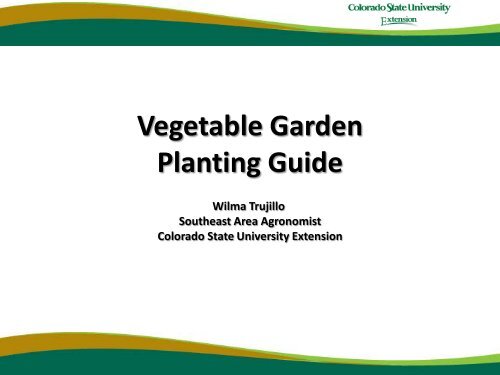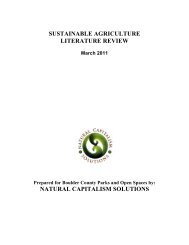Vegetable Garden Planting Guide - Colorado State University ...
Vegetable Garden Planting Guide - Colorado State University ...
Vegetable Garden Planting Guide - Colorado State University ...
You also want an ePaper? Increase the reach of your titles
YUMPU automatically turns print PDFs into web optimized ePapers that Google loves.
<strong>Vegetable</strong> <strong>Garden</strong><br />
<strong>Planting</strong> <strong>Guide</strong><br />
Wilma Trujillo<br />
Southeast Area Agronomist<br />
<strong>Colorado</strong> <strong>State</strong> <strong>University</strong> Extension
<strong>Vegetable</strong> <strong>Garden</strong><br />
Excellent source of fresh and nutritious vegetable<br />
Brings relaxation and enjoyment for the entire family<br />
Simple tools<br />
Little space<br />
Anybody can be a successful home gardener
How much time are you going to devote to the garden?<br />
What kind of terrain and soil do you have?<br />
What size?<br />
<strong>Vegetable</strong> <strong>Garden</strong>
Easier to maintain<br />
Increase yield<br />
<strong>Garden</strong> Layout<br />
Rows<br />
Beds<br />
• Single<br />
• Wide<br />
Best use of space • Raised Beds<br />
• Box Beds
Row Layout<br />
Large area<br />
Advantages<br />
Each row is a different vegetable<br />
North to South<br />
Enough space between row<br />
Disadvantages<br />
Soil compaction<br />
More pest attacks
Block-Style<br />
(close row or wide-row)<br />
<strong>Garden</strong> Layout
Plant in block<br />
<strong>Vegetable</strong> are planted closer<br />
Ideal for small areas<br />
Size 3 ft x 4 ft and depth 8” to 12”<br />
Earlier planting<br />
Better drainage<br />
Raised Bed Layout
Suggested Spacing<br />
<strong>Vegetable</strong> Spacing<br />
Beans and Peas 4" x 12"<br />
Beets 4 -6" x 4-6"<br />
Broccoli/ Cabbage/Cauliflowers 18" x 18"<br />
Carrots 2-3" x 2-3"<br />
Celery 7-9" x 7-9"<br />
Cucumbers 9-12" x 9-12"<br />
Garlic 4 -6" x 4-6"<br />
Lettuce, head 10-12” x 10-12"<br />
Lettuce, leaf 7-9" x 7-9"<br />
Eggplant 18-24" x 18-24"<br />
Onion, bunching 2-3" x 2-3"<br />
Onion, dry 4 -6" x 4-6"<br />
Peppers 15” x 15"<br />
Potatoes 12-15" x 12-15"<br />
Radishes 2-3" x 2-3"<br />
Squash/Cantaloupe/Watermelon 48”-72” x 48”-72”<br />
Spinach 4 -6" x 4-6"<br />
Tomatoes 24" x 24"
<strong>Vegetable</strong> <strong>Planting</strong> <strong>Guide</strong><br />
Cool Season <strong>Vegetable</strong><br />
Hardy <strong>Vegetable</strong> Semi-Hardy <strong>Vegetable</strong><br />
Broccoli Beets<br />
Cabbage Carrots<br />
Kohlrabi Cauliflower<br />
Onions Parsley<br />
Lettuce Potatoes<br />
Peas<br />
Radish<br />
Spinach<br />
Cool growing temperature (60 0<br />
to 80 0 F)<br />
Lose quality in hot weather<br />
Prefer a cool soil<br />
Plant based on soil temperature<br />
4 weeks before the date of<br />
the average last spring frost<br />
Often replanted mid-summer<br />
for fall harvest
<strong>Vegetable</strong> <strong>Planting</strong> <strong>Guide</strong><br />
Warm Season <strong>Vegetable</strong><br />
Tender <strong>Vegetable</strong> Very tender<br />
Beans Lima Beans<br />
Celery Cantaloupe<br />
Corn Eggplant<br />
Cucumbers Tomatoes<br />
Summer Squash Peppers<br />
Winter Squash<br />
Watermelon<br />
Daytime temperature above 60 0 F<br />
Summer like weather with temperature<br />
70 0 to 95 0 F<br />
Intolerant to frost<br />
Sensitive to cool spring winds<br />
Plant based on soil temperature<br />
Planted from seeds around the date<br />
of average last spring frost<br />
Very tender vegetable planted 2 +<br />
week after last spring frost
Plant<br />
Harvest
Symptom Cause Solutions<br />
Yellow and stunted plants<br />
Nutrient deficiency or Use fertilizer and correct pH<br />
abnormal soil pH<br />
3 to 4 lb. per 100 sq. ft.<br />
Compact soil or poor drainage<br />
Add organic material or coarse<br />
sand<br />
Insects or disease Pesticides<br />
Poor quality seed or plant Use high quality seed<br />
Stunted and purplish color Low temperature Plant at proper time<br />
Holes in leaves, yellowish<br />
and dropping leaves<br />
Insect damages Insecticides
Symptom Cause Solutions<br />
Leaves with spots; dead, dried<br />
areas; or powdery or rusty<br />
Wilty plants even though<br />
water is plenty<br />
Weak root system<br />
Tall plants; unproductive<br />
Drop flowers, buds<br />
Plant disease<br />
Resistant varieties; remove<br />
diseased plants; pesticides<br />
Salts<br />
Root damage<br />
Soil test<br />
Insects or nematodes<br />
damage<br />
Pesticides<br />
Poor drainage<br />
Add organic material or<br />
coarse sand<br />
Excessive shade Relocate to sunny area<br />
Excessive nitrogen<br />
Reduce application of<br />
nitrogen<br />
Hot, dry period Mulch, water<br />
Low night temperature<br />
Avoid planting too early in<br />
the season<br />
Overwatering or disease Stop watering; pesticides
QUESTIONS?
Wilma Trujillo<br />
1001 S Main Street<br />
Lamar, CO 81052<br />
Tel: 719 336-7734 (Office)<br />
719 688-9168 (Cell)<br />
Email: wilma.trujillo@colostate.edu

















